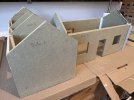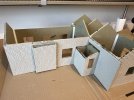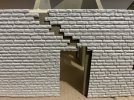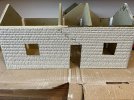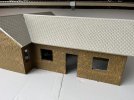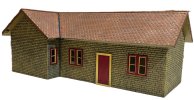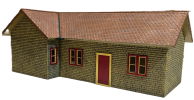JimmyB
Now retired - trains and fishing
This is my build of the Jackson's Miniatures (JM)- "Raven Square" Station. I will work my way through the build, giving my thoughts, and deviations from the instructions:
First though, the kit was bought second hand through the well known auction site, and it was untouched.
On opening the boxes though, I did find some additional parts. The parts in the box were all the wood (MDF) for the station, plastic stone embossed sheets to clad the walls (no roof sheets) JM doors and windows for the station an eight page instruction booklet, and a number of additional pieces of wood, which will make up a signal box.
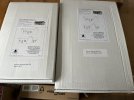

The first part of the instruction is to read ALL the instructions before starting, and dry fit before assembly. It does suggest painting before assembly, but as I was cladding the building, and having previously had problems sticking paint components together I decided not to. The recommended adhesive is EvoStick "Wet Grab", which is a polymer panel adhesive, which is what I have used, however the cure time being 24 hours, and the "messiness" of the adhesive for this use, I might not use it on the signal box.
Assembly does go together easily, but with anything of this nature "you can't have enough clamps" the white bits are pieces of paper to stop the adhesive sicking to my clamps and square corner pieces. This is the main building, the leg was just more adhesive, more clamps and more waiting once this had dried.
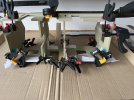
Endnote: to add strength I did run fillets of adhesive on all internal corners.
First though, the kit was bought second hand through the well known auction site, and it was untouched.
On opening the boxes though, I did find some additional parts. The parts in the box were all the wood (MDF) for the station, plastic stone embossed sheets to clad the walls (no roof sheets) JM doors and windows for the station an eight page instruction booklet, and a number of additional pieces of wood, which will make up a signal box.


The first part of the instruction is to read ALL the instructions before starting, and dry fit before assembly. It does suggest painting before assembly, but as I was cladding the building, and having previously had problems sticking paint components together I decided not to. The recommended adhesive is EvoStick "Wet Grab", which is a polymer panel adhesive, which is what I have used, however the cure time being 24 hours, and the "messiness" of the adhesive for this use, I might not use it on the signal box.
Assembly does go together easily, but with anything of this nature "you can't have enough clamps" the white bits are pieces of paper to stop the adhesive sicking to my clamps and square corner pieces. This is the main building, the leg was just more adhesive, more clamps and more waiting once this had dried.

Endnote: to add strength I did run fillets of adhesive on all internal corners.
Last edited:

